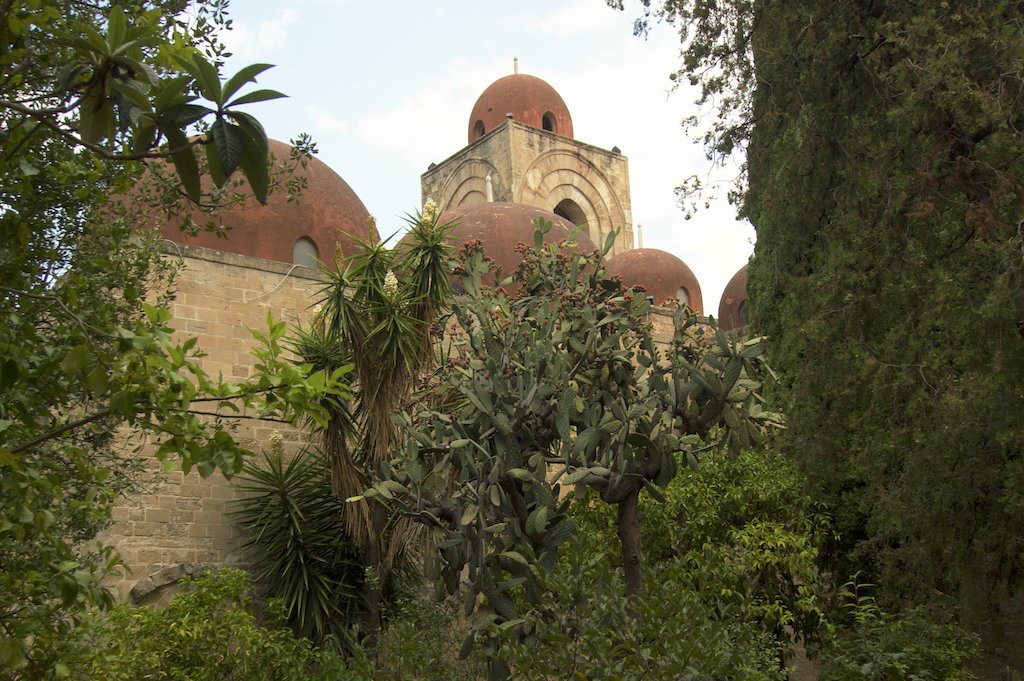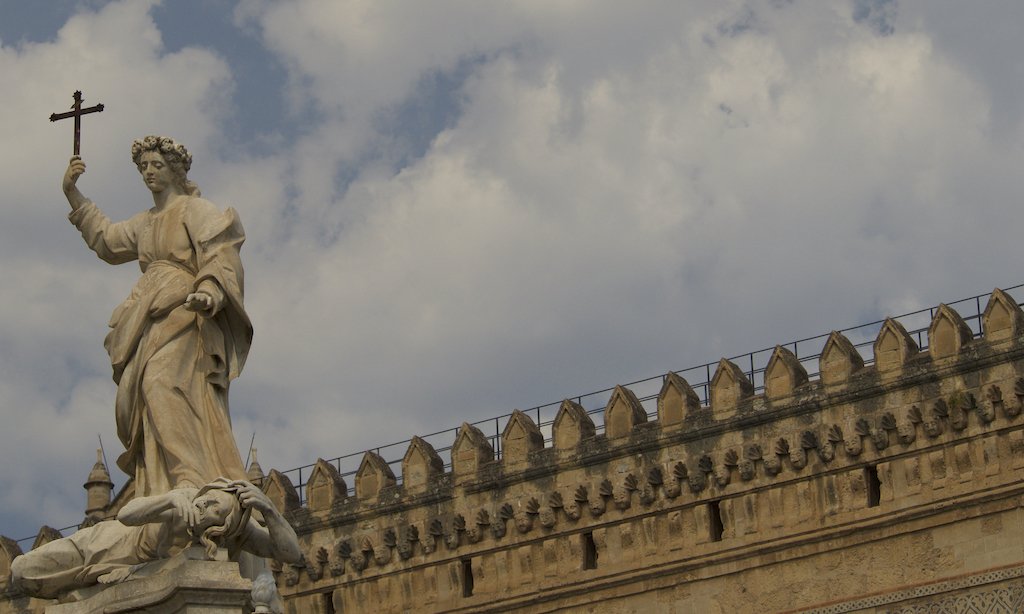Ashes and blue skies: a Palermo travelogue.
Warm air rushes in to fill the plane. We disembark by row, adhering scrupulously to the new socially-distant orthodoxy, ditching jumpers and jackets as we do: summer might be a distant memory where we left off, washed away in the London drizzle, but here it’s not over yet.
It’s a warm night with none of the oppressive heat that weighs over the Po river valley for much of the good season. Here there are no mosquitoes and a little humidity laced with a faint smell of sand and vegetation. You don’t sweat standing still, here.
Palermo flows under the yellow glare of sodium lamps; the taxi leaves the motorway and cruises into a regular grid of buildings of varying degrees of ugliness, carbon-copy of countless such tenements infesting every corner of the peninsula: from Milan to Mazara, from Ventimiglia to Villa Opicina, everything built between 1960 and 1990 has been a crime against architecture and good taste. Then, thankfully, streets grow smaller, buildings older, the traffic denser.
As is customary, I’ve arrived here without the foggiest idea of what to expect. Come to think of it, I know very little about this city that hasn’t got to do with its conquest by the Corleonesi in the 1980s. But that was the past: Totò Riina died the death he deserved, under arrest. Binnu Provenzano met the same fate, kicking the bucket without ever seeing the hard prison regime lifted. Even il Divo Giulio, Andreotti, has died in 2013 and undoubtedly the devil is still trying to decide in which circle of hell to have him thrown. A man with his pedigree belongs in basically all of them.
I imagined a city of quiet, winding alleys, whispered conversations, largely asleep this time of night. I was wrong.
Palermo’s old town is alive at eleven PM. I walk the roads of La Kalsa, the old Arab quarter, aiming for the apartment I’ll be staying at for the night; meanwhile, hundreds of Palermitans eat, drink and chat at countless open-air tables. I, too, stop for a beer and a pane e panelle, bread with a chickpea flour fritter; I ask the bartender if I can sit outside, at the dehor. She looks as if I’m speaking a different language and, in a sense, I am. Piedmont and Sicily have drifted somewhat apart in the 1300 years that lapsed between when they were united.
I join the crowds on via Maqueda, shuttling up and down. Far from being silent, quiet and hidden away, Palermo is as flamboyant as the crowd outside a Leblon bar. The youngsters, in particular, are a sight to behold. Young tanned women stroll in flowing robes while their male companions peacock wearing floral-printed shirts, tailored pin-striped linen trousers with high hems and loafers, a mixture of 1980s looks and Von Humboldt’s botanical drawings. Looking at them I’m reminded again that, if style were to be a prerequisite for citizenship, I’d have my passport revoked.
This is a city that doesn’t quite like being up early, or so it seems. When I go out for a jog, at 6:30 AM the following day, I’m alone in the tortuous streets of the old town. Yesterday’s revellers have gone, leaving in their wake a prodigious amount of rubbish. As I jog it occurs to me that I haven’t witnessed anyone caught in the act of littering – and nor will I for the entire duration of my stay – and yet the pavements are constellated with the detritus of the city, like Monday mornings in Camden when the foxes have beaten the council to the bin bags left out by residents.
I turn into via Libertà and Palermo changes face. Gone are the alleys, the labyrinthine texture of the medieval city. I run along neatly-arranged blocks of flats, genteel turn-of-the-century mansions with peach stucco, palm trees, cast iron railings and all those lovely finishing touches that add extra zeros to the real estate prices. Two street sweepers brush off dead leaves from the counterflows.
I turn right again, aiming for that sea that glitters occasionally at the end of some of the boulevards. I run past the terrifying walls of Ucciardone prison, a Panopticon gaol of unmitigated ugliness squatting on the edge of downtown, holding it in its grip. The road I’m running on degrades into a battered sidewalk littered with dog turds, but I press on: the seaside must be close. But, eventually, I’m defeated: a concrete wall blocks my progress, a rampart protecting the fort of the port as far as the eye can see. Cranes are busy at work behind it and I’m not invited.
There’s a lovely beach in Mondello, a suburb beyond the coastal mountain that can be seen from anywhere in town. There’s soft sand, kiosks selling granitas, fish restaurants and a sea that goes from jade green to aquamarine to indigo; but nothing of that kind exists downtown. My run done, I return to the waterfront and find only a deserted stretch of grass and vistas of unfiltered industrialism. An exploration vessel under repair. A forest of cranes and other oil paraphernalia. Aging tankers. Cruise ships, hibernating until Covid-19 stops transforming their ilk into floating petri dishes. Palermo has no Promenade des Anglais, no via Caracciolo. It’s as if this city on an island looked at the sea and went “Thanks but no thanks”. Perhaps it doesn’t need it.
Ash rains silently over the city. Tiny flakes, grey and black, fall from the sky. They were trees, shrubs, grass: now they are nothing but impalpable, charred curls of organic matter, reminders of what once was.
“There’s a fire above Altofonte”, says the bartender of a café where I stopped for a coffee and a brioche. Except it’s a cornetto, here, as he politely points out. Filled with pistachio and ricotta and as addictive as anything shipped by the French connection.
A fellow customer is less laconic. “Some cornuto started five fires at the same time”, he says before unleashing a carpet bombing of curses in dialect. There’s plenty of appreciation for the arsonist, his mother and sisters but, unlike in the North, no deities and farm animals. Sicilians don’t do blasphemy. “The Canadair’s been doing the rounds since six” concludes the bartender; as if on cue, the drone of a prop plane ripples through the bar.
A yellow-and-red Civil Protection plane had been shuttling between the sea and the dry hills of the interior. It zoomed in the slices of sky cut by the buildings, a lightning apparition of straight wings, floaters and amphibious belly.
More ship than airplane, the CL-415 water bomber will forever be known, in Italy, as “The Canadair”, even though its maker has changed name twice since being called such. Whatever its moniker, the Canadair is, arguably, the nation’s most beloved airplane. Nary a soul has anything bad to say about this son of the great North; more than once, in the five hours it took to quell the blaze, I witnessed Palermitans smile at the red-and-yellow propper as it flew sortie after sortie, slamming six tonnes of seawater into the flames with remarkably un-Canadian violence.
Call it ignorance, call it the prejudice of a polenta-eating northerner, but I expected that Palermo’s downtown – the poorer, dilapidated streets of La Kalsa and Borgo Vecchio – be inhabited by old men wearing coppolas and corduroys, leathery faces and bendy legs, sitting outside with expressions as stony as an Easter Island moai. Once again, I was wrong.
Doorbells, in La Kalsa, yield a microcosm of surnames: pure Sicilian ones and a whirlwind tour of the Subcontinent with Bengali, Punjabi and Tamil names written in scrupulous all-caps. A CISL branch – the Catholic trade union – has notices written in Italian and Bangla abugida.
The narrow streets facilitate a tentative, un-scripted and spontaneous integration, haphazard and chaotic as most things are in Italy. Volunteers at an ophthalmology clinic chat with an African family; a group of friends of different ethnicities pose for Instagram snaps at the port, speaking with the same accent, the same wide vowels. Mixed couples walk under umbrellas during a brief and unexpected squall.
There’s an ease in all this, suggesting that this isn’t Palermo’s first rodeo. And it's true: everyone, from the Phoenicians to the Americans, has been here. Muslim carpenters built the monastery of the Eremiti, garnishing it with red domes and spikes as the mosques in which they prayed. Verse 54 of the 7th Surah of the Koran is carved on a pillar of the city’s cathedral. A man bundles his children and beach paraphernalia into a Jeep; his right forearm emblazoned with the tattoo of a crucifix; on the left is a sentence in Arabic.
There are two stereotypes, when discussing the South, I don’t want to fall into: mafia and laziness. One is a lot harder to dodge than the other and, try as much as I do, I find myself falling into the latter. North of the Vucciria market, now a skeleton of the former self that enthralled Peter Robb and Leonardo Sciascia, is a block of tightly-packed houses left untouched from the days when the Allied forces, in 1943, bombed the city; not far from there is a small shrine left by a pious hand asking for help from the Almighty to clear the city of the rubbish. I wish to be able to say that my mind didn’t run to a Lombard phrase, “bun de fà nient”, good-for-nothing, that my grandma used when seeing these behaviours, but I’d be lying.
A sign, outside Judge Borsellino’s birthplace, marks it as the starting point for the rejuvenation – risanamento – of the old town. It’s dated 1993. Naples, Bari, Lecce, Taranto have all accomplished that in a fraction of the time. Palermo hasn’t.
It’s easy to be a pessimist about Sicily, but I’m not. I leave Palermo enthralled and frustrated, amazed and confused, enamoured and disgusted but, above all, optimistic. First impressions are often misleading, but I leave this city knowing that there’s something – the people, the sense of community, an air of go-getting – that tells me that things will get better.






